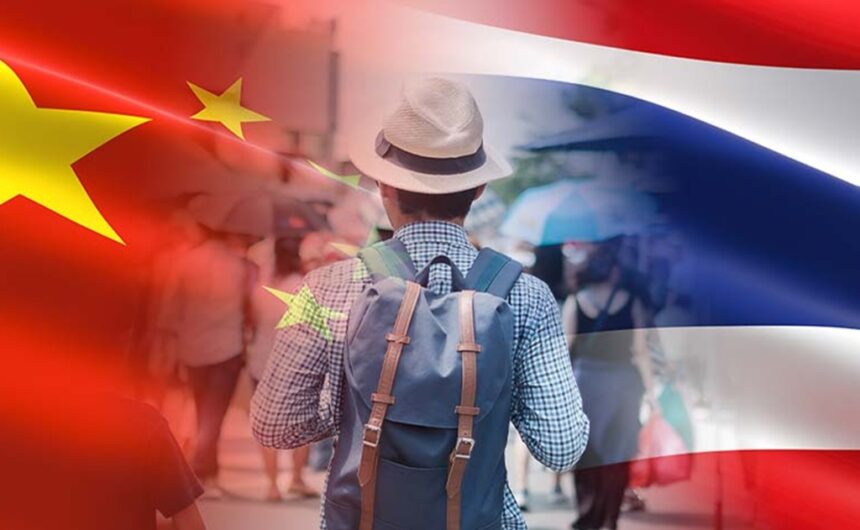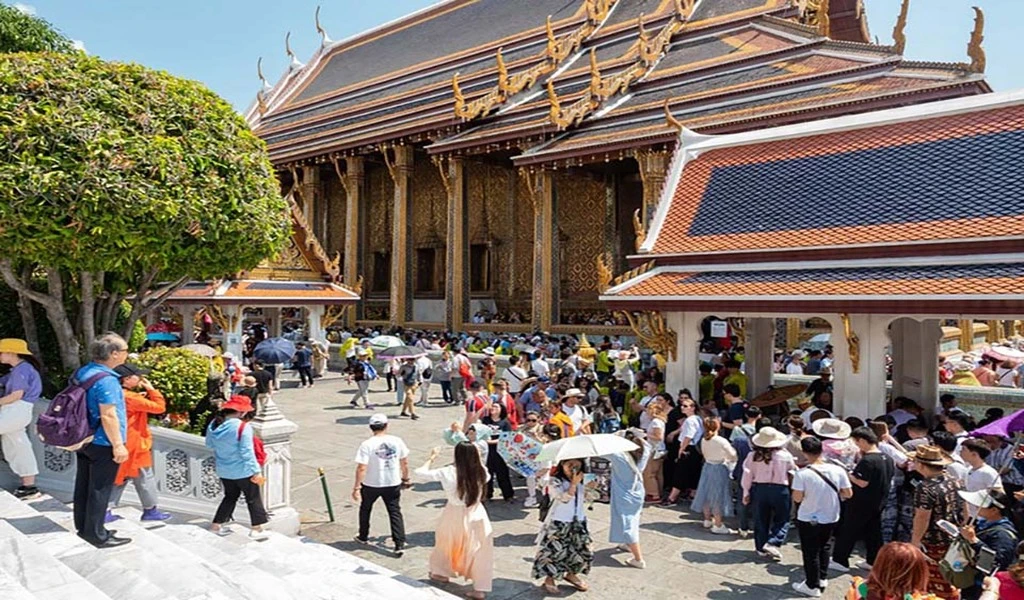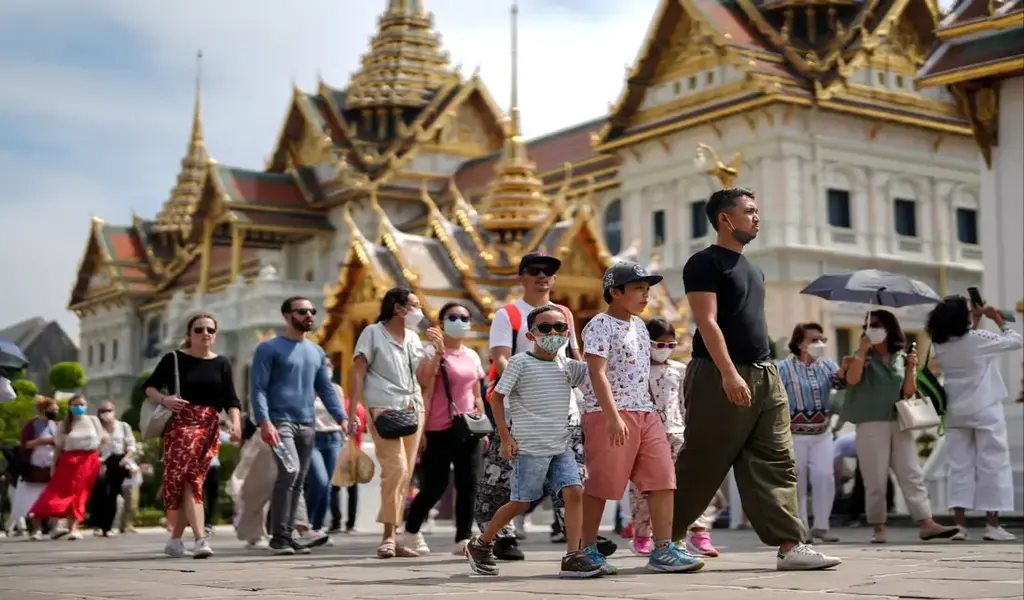BANGKOK—It’s impossible to ignore the empty tour buses and quieter beaches in Thailand this year. The drop in Chinese travellers is striking—Chinese tourists once made up a third of all visitors, but their numbers have now plummeted by over 20% since early 2025.
This isn’t just a dip; it’s a sign of bigger problems. China’s economic slowdown, safety concerns, and growing competition from places like Vietnam have all played a part.
For Thailand, the stakes couldn’t be higher. Tourism fuels jobs, small businesses, and the broader economy. With Chinese arrivals falling well short of government targets, Thailand faces increased pressure to fill the gap.
This has sparked urgent moves to refresh its image, attract new markets, and rethink how it competes with neighbours for travellers’ attention—and dollars. The next sections dig into how these shifts are playing out and what’s at risk for the country’s future.
Chinese Economic Slowdown and Changing Outbound Tourism Patterns
China’s fading economic momentum is shifting not just its markets, but also the entire tourism map in Asia. As China faces a mix of structural issues, nervous consumers, and shifting global relations, its people are making new holiday choices. For Thailand, this has meant fewer Chinese visitors and more competition from nearby destinations, each making their play for the once-booming Chinese travel market.
Domestic Tourism Stimulus in China
With much of the world’s attention on falling Chinese visitor numbers abroad, it’s easy to overlook what’s happening at home. Beijing has quickly stepped up efforts to keep travel dollars circulating within China’s borders. Through heavy promotion of “staycations,” discounts on local attractions, and splashy travel festivals, local governments are hoping to counteract the sting of a sluggish economy.
Record-breaking domestic travel during the May Day holiday, for example, underscored how mainland Chinese are choosing to explore their backyard rather than venture further afield. For many, tighter budgets and stricter travel rules make a local getaway more sensible.
The result? While international hot spots like Thailand see emptier hotels, tourist sites across China are bustling with visitors looking for value and convenience. This trend is no accident; it’s the outcome of government strategy as well as growing pride and comfort in domestic destinations. For a deeper dive into these shifts, China’s May Day 2025 Travel Boom Breaks Records gives a clear look at how Chinese vacation habits are changing.
Economic Precaution and Consumer Spending Shifts
There’s a new sense of caution running through China’s middle class. Factors such as mounting local debt, a faltering property sector, and global trade turbulence have squeezed disposable incomes. People are thinking twice about where and how they spend their money, especially on big-ticket items like overseas holidays.
With job security less assured and investment returns looking shaky, the instinct is to hold back on discretionary spending. For many would-be travellers, this means opting for shorter, domestic trips or even delaying vacations altogether. Luxury spending is also shifting: while high-end travel remains popular for some, most households are seeking better value and flexibility.
This shift isn’t isolated. Analysts point out that it is a structural change in Chinese society, driven by long-term issues, not just short-term fear. Debt, demographics, and changing attitudes towards savings all factor in, leading to fewer lavish trips abroad. To get the big picture, China’s Economic Slowdown: Unravelling Structural Causes and Global Repercussions explores the roots and outcomes of these economic shifts.
Regional Competition: Vietnam and Japan’s Rising Popularity
While outbound travel from China has dropped overall, destinations like Japan and Vietnam are making big gains. Why? Both offer close, affordable, and safe options that appeal to budget-conscious and cautious Chinese travellers. Smart visa policies, direct flights, and savvy marketing have given these countries a clear edge.
- Vietnam: With competitive prices and vibrant culture, Vietnam is now seen as a “best value” pick, especially for families and young adventurers. The country’s beaches, historic towns, and foodie scenes attract those wanting experiences that feel both accessible and exciting.
- Japan: Japanese destinations score high with Chinese tourists for safety, quality, and unique seasonal festivals. Recent yen weakness has made Japan more affordable, leading to a surge in Chinese visitors despite overall travel cutbacks.
Thailand, for comparison, is now facing stiff competition to remain relevant to this key group. As more Chinese tourists head to these new favourites, Thailand’s government and businesses are feeling the urgency. They not only compete on price and experience, but must also reckon with changing consumer expectations fuelled by China’s economic caution.
For a breakdown of these changing travel habits, Chinese luxury travellers in 2025 are spontaneous and social-first, highlighting how experience-driven travel is reshaping regional demand.
New patterns in Chinese tourism mirror deeper changes at home and abroad. For Thailand, the challenge is not just to respond, but to rethink its appeal in a fast-changing regional travel market.
Safety and Geopolitical Concerns: Eroding Confidence in Thailand
Concerns about personal safety and growing political friction have thrown a cloud over Thailand’s once-flourishing reputation among Chinese tourists. The data shows fewer Chinese arrivals, but when you look at what people are saying online and in official statements, the problem runs deeper than just economics. Safety issues and diplomatic rifts are driving real fear and hesitation. Here’s how these tensions are playing out and shaping travel trends.
High-Profile Incidents and Social Media Narratives
It doesn’t take much for a single incident to ripple through an entire travel market, especially with the speed of social media. Recent years have seen several high-profile safety scandals in Thailand, ranging from reports of violent crimes targeting tourists to scams and alleged police misconduct. These stories often gain traction in Chinese online spaces, fueling caution and worry among would-be travellers.
Negative news spreads fast on platforms like Weibo and WeChat. Shocking reports quickly become widespread “cautionary tales,” even when official investigations clear up some misunderstandings. Earthquakes, although rare, also make headlines and remind travellers of unpredictability. The drama is amplified by influencers and news accounts that highlight personal stories and warnings, sometimes overshadowing the facts.
Opinion leaders within China have amplified these worries, pointing to issues like
- High-profile high-speed boat accidents in popular Thai resorts,
- Concerns about street crime or tourist-targeted scams,
- Uproar over alleged cases of random violence against foreign guests.
As discussed in tourism research, both rational concerns and emotional reactions drive Chinese travel decisions during times of perceived crisis. Studies have revealed that negative online sentiment can have just as much effect as official safety warnings.
Tourism officials on both sides acknowledge the issue. Thai spokespersons have stressed that steps are being taken to restore confidence, ranging from visible police patrols to dedicated Chinese-language support services. At the same time, Chinese tourism officials have openly advised citizens to pay close attention to travel advisories and to choose destinations based on current security levels. For more on how media coverage shapes perceptions, this analysis on media exposure and Chinese tourists’ travel intentions dives into the issue.
Diplomatic and Geopolitical Tensions
Thailand’s relationships with regional and global powers also weigh on travel plans. Geopolitics can spill over into tourism in surprising ways. In the past year, diplomatic tensions have made headlines—whether it’s over regional disagreements, controversial bilateral deals, or broader power struggles between the US and China.
For example, a recent agreement between Thailand and Cambodia triggered warnings about unrest and protests, making safety a concern for visiting tourists. Chinese headlines about corruption crackdowns and visa issues have added to the uncertainty. Meanwhile, Thailand finds itself needing to balance ties between China and other international partners, which can add stress to visa decisions and even airport security.
Tourism officials are walking a tightrope. On one hand, the Thai government is shifting its focus towards attracting what it calls “quality visitors”—offering reassurances but also ramping up scrutiny in response to scam concerns. This move is highlighted in local reports, suggesting the government expects a long haul before Chinese visitor levels bounce back. For a look at how these shifts are addressed locally, read this piece: Thailand Shifts Tourism Focus to Quality Visitors Amid Scam Crackdown.
Diplomatic and safety anxieties feed off each other. When combined with economic caution and fierce competition from neighbouring destinations, the result is a lot more empty seats on flights to Thailand. The challenge for Thailand will be restoring trust, rebuilding its image, and looking for ways to reassure not just the Chinese public, but also the new wave of international travellers who now view safety and stability as must-haves.
Tourism Sector Responses and New Strategies for Recovery
Facing a steep drop in Chinese visitors, Thailand’s tourism sector has switched gears. Instead of waiting for old patterns to return, the country’s leaders have taken action. New campaigns aim to rebuild lost trust, while visa changes and marketing stunts seek to bring back Chinese travellers—and capture new ones. Here’s how Thailand is responding to one of its toughest travel challenges in years.
Mega Fam Trip and ‘Sawasdee Ni Hao’ Campaigns
To fight falling numbers, Thailand’s Tourism Authority (TAT) rolled out the ‘Mega Fam Trip’ as a showpiece effort. This campaign invites top Chinese travel agents, influencers, and digital content creators for immersive trips across Thailand’s secondary cities and lesser-known gems. The strategy is clear: deliver genuine, influencer-driven experiences that are then broadcast back to millions in China through social media, livestreams, and vlogs.
Key highlights of these campaigns include:
- Hosting large groups of Chinese travel writers for real-life tours and hands-on adventures.
- Encouraging influencers to share safety updates and positive stories from direct experience.
- Focusing storytelling on Thailand’s unique local experiences, hospitality, and improved security measures.
Another major move is the ‘Sawasdee Ni Hao’ campaign, which has blended familiar Thai hospitality with a direct appeal to Chinese travellers. This program ramps up the welcome with Chinese-language guides, special shopping deals, and dedicated help desks at major airports. The personal touch matters—a warm greeting, quick service, and answers in Chinese can turn anxiety into curiosity.
If you want more details on these evolving marketing plans, an in-depth breakdown on how Thailand plans to recover with new campaigns gives a clear look at what’s next for Thai tourism.
Visa Policy Adjustments and Bilateral Initiatives
To remove obstacles, the Thai government has overhauled visa policies. Fast-track visa approvals, simplified forms in Chinese, and fee waivers are now common. The focus isn’t just on easier paperwork—direct flights, joint promotions with airlines, and quick airport entry are all selling points.
These practical changes now include:
- Temporary visa fee waivers for Chinese visitors to cut travel costs.
- More flights between top Chinese cities and new Thai gateways, so travel is direct.
- Bilateral talks with China to align travel rules and boost confidence, aiming for a smoother experience.
Some of these decisions reflect a shift in policy from chasing large tourist volumes to securing higher spending “quality” visitors—a change seen as necessary with slow economic recovery and changing travel habits in China. These moves are not only about economics but also diplomacy, signalling that Thailand values close ties with Chinese tourists and is willing to invest in the relationship. A recent report from Skift shows how Thailand is rethinking its goals and adjusting visitor targets with these new strategies.
Enhancing Perceptions of Safety
Safety remains the biggest worry for Chinese visitors. After a string of negative headlines, Thailand has slammed the brakes on complacency. In 2025, new initiatives aim to reassure anxious travellers at every touchpoint.
Concrete steps include:
- Increased visibility of tourist police and Chinese-speaking officers in key destinations.
- Launching real-time safety updates via WeChat and other popular Chinese apps.
- Working with major hotel chains and shopping malls on visible emergency response drills.
Communication matters as much as action. By publicising these changes and spotlighting positive stories from Chinese guests, Thailand hopes to reset the narrative. The TAT has also worked on partnerships with China’s biggest online travel agencies, so clear information about local safety can be easily found before booking.
While challenges remain, heavy investment in marketing, digital outreach, and personal reassurance is already paying off. Recent news confirms a THB 3.5 billion stimulus package for the tourism sector, allocated in part to fund these new initiatives and rebuild trust.
As Thailand continues recalibrating its approach, the lesson is clear: resilience and adaptability—in marketing, security, and guest experience—are crucial for any country hoping to thrive in today’s tricky tourism market.
Charting the Future: Risks, Opportunities and Structural Reforms Needed
Thailand’s tourism industry has always been tied to the fortunes of Chinese travellers. When the numbers go up, jobs and local businesses see the benefits quickly. But with a slow rebound in Chinese arrivals, there are real risks ahead. The government and business leaders now have to look beyond short-term fixes and think about bolder changes. A full recovery isn’t guaranteed, and doing nothing means bigger shocks in the future. Let’s look at promising signs, urgent needs and the lessons Thailand—and its ASEAN neighbours—can use to secure their tourism future.
Prospects for Chinese Tourist Recovery
The outlook for Chinese tourist returns is still uncertain, even as travel restrictions have eased. Optimists point to the reopening of China’s borders, a growing appetite for international trips and new marketing campaigns. Yet the excitement is tempered by ongoing caution.
Economic worry in China is slowing the pace of outbound travel. Even with Thailand’s efforts, some forecasts now suggest that Chinese visitor numbers in 2025 could fall below 4 million, far from pre-pandemic records.
The government recently admitted this in planning documents, trimming visitor targets and setting more realistic revenue aims for the year (Thailand Cuts Chinese Tourist Target, Plans Recovery). If current trends hold, the big-spending Chinese traveller will remain a rare sight. This shift has direct effects on jobs, local businesses and GDP. Lower arrivals put a squeeze on restaurants, shopping malls and hotel chains, especially in hotspots like Phuket and Pattaya that once relied heavily on Chinese group tours.
Still, it’s not just about numbers. Changes in Chinese travel habits offer openings: smaller groups, independent travellers, and a new focus on cultural experiences could help support high-value tourism, if Thailand adapts quickly enough.
Diversifying Source Markets and Improving Infrastructure
Thailand can’t afford to put all its eggs in one basket. To weather ongoing uncertainty, the country is ramping up its push for new tourist markets. This means increasing visits from places like India, Russia, Malaysia and even new targets in the Middle East.
A balanced approach includes:
- Expanding airline routes to secondary cities, making Thailand more accessible for a broader range of visitors.
- Investing in multilingual services, not just the Chinese language, but also Hindi, Russian and Arabic.
- Tuning campaigns for independent travellers who want to explore local cultures, food scenes and history instead of just package tours.
Better infrastructure is equally important. Modern airports, smooth rail connections and world-class safety standards all play their part. Smart investments—like digital tourist services, green transport, and improved waste management—don’t just boost tourist confidence, they also help communities that host them.
Recent ASEAN plans show that focusing on sustainable growth and improved management can cushion against shocks (ASEAN Framework on Sustainable Tourism Development). Thailand is already using programs started during the pandemic, like the Phuket Sandbox, to test new ways of managing visitors and diversifying tourist flows.
Lessons for Thailand and Regional Competitors
There’s a lesson in every struggle. For Thailand and neighbouring destinations, the current challenge reveals what works and what needs fixing.
Key takeaways include:
- Avoid overdependence on any single market. As seen in 2025, a slump in Chinese arrivals can hit hard, but a more diverse portfolio brings stability.
- Build partnerships across ASEAN to promote cross-border travel, share safety standards and coordinate responses to crises.
- Make safety, health and digital services top priorities. Tourists want clear info, quick help and confidence that their trip won’t be derailed.
- Invest in workforce training and local business support, so economic benefits are spread out and not just concentrated in tourist hotspots.
ASEAN’s new tourism roadmap highlights the power of regional thinking (Action Roadmap for Sustainable Tourism Development in ASEAN). When countries align on marketing, standards and connectivity, everyone benefits. The region’s long-term strength will come not from chasing raw visitor counts, but by offering genuine value, safety and a memorable experience for every guest.
Thailand has the tools and the ideas to move forward. But the lesson of 2025 is clear: those who adapt, collaborate and innovate fastest will shape tourism’s future for Thailand and all of Southeast Asia.


















